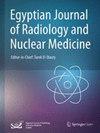Predicting of hepatic steatosis in living liver donor via CT liver attenuation index (LAI) and fibroscan controlled attenuation parameter (CAP) correlation with biopsy result
IF 0.5
Q4 RADIOLOGY, NUCLEAR MEDICINE & MEDICAL IMAGING
Egyptian Journal of Radiology and Nuclear Medicine
Pub Date : 2024-09-02
DOI:10.1186/s43055-024-01335-7
引用次数: 0
Abstract
The most prevalent persistent parenchymatous liver alterations in healthy individuals are thought to be hepatic steatosis. The liver biopsy is the most crucial procedure for the identification and measurement of hepatic steatosis. By identifying the liver attenuation index (LAI) at CT image with fibroscan controlled attenuation parameter (CAP), hepatic steatosis can be evaluated without the risk of liver resection. Using liver biopsy histological analysis as a reference standard, to examine the precision of the CT liver attenuation index (LAI) and fibroscan controlled attenuation parameter (CAP) for quantitative evaluation of macrovesicular steatosis in living related liver donors. In this cross-sectional study, comparing the CT liver attenuation index & fibroscan controlled attenuation parameter with liver biopsy result for the detection of the steatosis in subject's candidate for liver living donors, 50 subjects were conducted at Ain Shams Specialized Hospital and other private hospitals over about 2 years. Our study reported that liver attenuation index of 9 is the cutoff value in post-contrast CT images with sensitivity 100% and specificity 80% that make it a very good method to exclude donor to have steatosis ≥ 15%, which mean that if donor had LAI index < 9, we can safely do proceed do liver biopsy. Our study reported that CAP measurement had an AUROC OF 0.780, for detecting steatosis ≥ 15%, with sensitivity is only 60% with specificity as CT LAI of 80%, our results consider low compared to other studies, that could be due to small number of donors in our study with steatosis ≥ 15% (five cases from 50 donors) unlike the other studies. When used to estimate the amount of liver fat in liver donors, the examined CAP and CT indices worked equally. But according to multivariate analysis, the only factor strongly linked with hepatic steatosis in a living donors was the CT LAI index. We contend that the combination of CT LS attenuation index and CAP allows for the detection of the degree of hepatic steatosis and can be used as an option to liver biopsy, reserving liver biopsy for those with positive steatosis donors.通过CT肝脏衰减指数(LAI)和纤维扫描控制衰减参数(CAP)与活体组织切片检查结果的相关性预测活体肝脏捐献者的肝脏脂肪变性
肝脂肪变性被认为是健康人最常见的持续性肝实质改变。肝脏活检是识别和测量肝脏脂肪变性的最关键程序。通过使用纤维扫描仪控制的衰减参数(CAP)来识别 CT 图像上的肝衰减指数(LAI),可以在没有肝切除风险的情况下评估肝脂肪变性。以肝活检组织学分析为参考标准,研究 CT 肝衰减指数(LAI)和纤维扫描可控衰减参数(CAP)用于定量评估活体肝脏供体大泡性脂肪变性的精确度。在这项横断面研究中,艾因夏姆斯专科医院和其他私立医院在大约两年的时间里对 50 名候选肝脏活体捐献者进行了研究,比较了 CT 肝脏衰减指数和纤维扫描控制衰减参数与肝脏活检结果对脂肪变性的检测结果。我们的研究报告显示,肝脏衰减指数 9 是对比后 CT 图像的临界值,灵敏度为 100%,特异性为 80%,是排除脂肪变性≥15% 的供体的非常好的方法,这意味着如果供体的 LAI 指数小于 9,我们就可以放心地进行肝脏活检。我们的研究报告显示,CAP 测量检测脂肪变性≥15% 的 AUROC 为 0.780,灵敏度仅为 60%,特异性为 CT LAI 的 80%,与其他研究相比,我们的结果较低,这可能是由于与其他研究不同,我们的研究中脂肪变性≥15% 的供体数量较少(50 名供体中有 5 例)。当用于估计肝脏捐献者的肝脏脂肪量时,所研究的 CAP 和 CT 指数效果相当。但根据多变量分析,唯一与活体供肝者肝脂肪变性密切相关的因素是 CT LAI 指数。我们认为,CT LS衰减指数和CAP的组合可以检测肝脏脂肪变性的程度,并可作为肝脏活组织检查的一种选择,为脂肪变性阳性的供体保留肝脏活组织检查。
本文章由计算机程序翻译,如有差异,请以英文原文为准。
求助全文
约1分钟内获得全文
求助全文
来源期刊

Egyptian Journal of Radiology and Nuclear Medicine
Medicine-Radiology, Nuclear Medicine and Imaging
CiteScore
1.70
自引率
10.00%
发文量
233
审稿时长
27 weeks
 求助内容:
求助内容: 应助结果提醒方式:
应助结果提醒方式:


